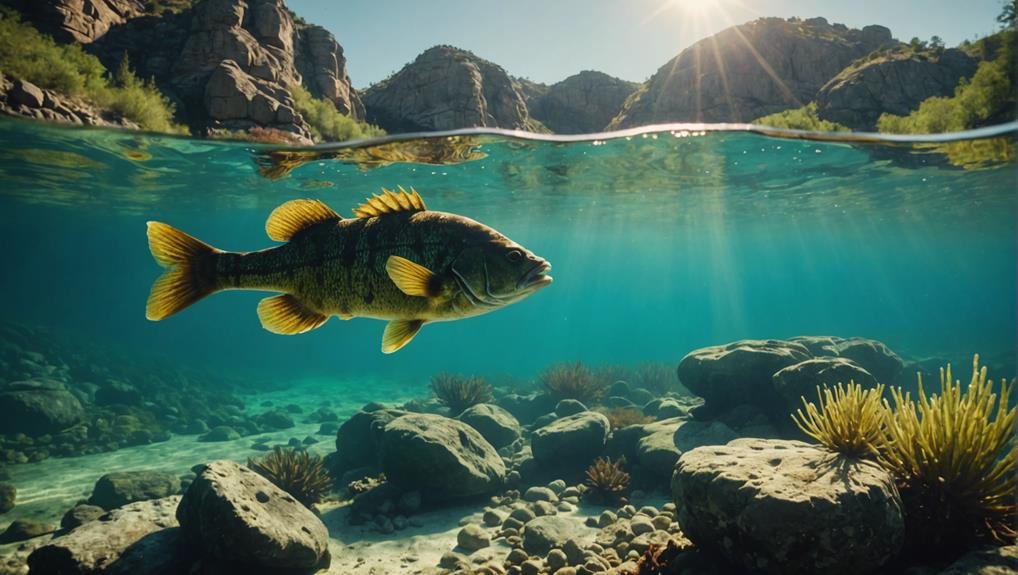Saguaro Lake is teeming with a diverse array of fish species thriving in its waters. Bluegill, recognized for their tendency to school together, primarily feed on insects and plant matter found near underwater structures. The impressive largemouth bass, capable of growing up to 30 inches in length, prey on smaller fish and crustaceans. Smallmouth bass, favoring shallower, rocky areas, have a varied diet that includes plankton and crayfish. Yellow bass, distinguished by their yellow or pale cream coloration, feed on crustaceans and smaller fish. Lastly, the sizable rainbow trout, known for their diet of insects and small fish, attract anglers skilled in fly-tying techniques. These species contribute to the rich ecosystem of Saguaro Lake, offering a fascinating experience for nature enthusiasts and anglers alike.
Bluegill
Known by various names like bream or sunnies, Bluegill (Lepomis macrochirus) typically reach lengths of 6-12 inches and boast vibrant green and blue hues. These fish thrive in a variety of habitats, from ponds to lakes and slow-moving streams. Bluegill are versatile eaters, enjoying insects, small fish, and plant matter, making them a popular catch for anglers of all levels. Their schooling behavior is evident, especially near underwater structures such as logs and vegetation. With their rapid reproduction rates, Bluegill remain a dominant species in many freshwater environments. Fishing for Bluegill is a favorite pastime for many due to their abundance and willingness to take the bait, making it a great starting point for beginners.
Largemouth Bass
Largemouth bass, scientifically known as Micropterus salmoides, are renowned for their insatiable hunger and serve as vital predators in freshwater environments. These carnivorous creatures can reach lengths of up to 30 inches and live for about 25 years. Recognizable by their large mouths and dark side stripes, they mainly prey on smaller fish, insects, and crustaceans. During the breeding season, male bass construct nests by digging depressions in gravel beds. These nests offer a secure space for females to lay their eggs. The males diligently guard the nests until the eggs hatch, ensuring the survival of the next generation. Largemouth bass play a crucial role in preserving the ecological equilibrium within their surroundings.
Smallmouth Bass

Smallmouth bass, scientifically known as Micropterus dolomieu, thrive in the shallower, rocky areas of Saguaro Lake. These fish, typically reaching lengths of 12-16 inches, are easily identifiable by the vertical bands on their bodies. They have a diverse diet that includes plankton, insects, crayfish, and other fish. An interesting aspect of their reproductive behavior is the construction of nests by males in shallow waters to protect their eggs.
Understanding these key characteristics is essential for both anglers and biologists to effectively manage and appreciate the smallmouth bass population in Saguaro Lake.
Yellow Bass
Yellow bass, scientifically known as Morone mississippiensis, have established themselves as a prominent species in Saguaro Lake, although they are often considered non-native. Thriving in clear waters with abundant vegetation, these fish find the lake's environment ideal for their habitat. During the spring, they engage in reproductive behavior by spawning in shallow waters and releasing eggs that settle on the lakebed. Yellow bass have a diverse diet, feeding on crustaceans, insects, and smaller fish. With moderate growth rates, they typically grow to an average length of 9 inches. Their distinctive yellow or pale cream coloration sets them apart from other species. Thanks to their adaptability and varied diet, yellow bass have successfully adapted to and thrived in their non-native surroundings.
Rainbow Trout

With their vivid blue-green or yellow-green hues, rainbow trout, also known as redband trout, are a captivating species found in Saguaro Lake. These trout can reach lengths of 20-30 inches and primarily feed on insects, crustaceans, and small fish. Anglers who enjoy trout fishing often employ fly tying techniques to lure them, imitating the insects that make up their diet. Unlike some fish, rainbow trout do not protect their nests while breeding, allowing their eggs to hatch naturally.
Understanding these characteristics can greatly enhance the experience of fishing for rainbow trout in Saguaro Lake.
Conclusion
Saguaro Lake is home to a diverse array of fish species, making it a prime destination for both fishing enthusiasts and nature lovers. One standout resident is the Largemouth bass, known to reach impressive lengths of up to 30 inches, showcasing the lake's thriving ecosystem. This fact underscores the lake's appeal for recreational fishing and scientific exploration alike. From the vibrant Bluegill to the elusive Walleye, each fish species plays a unique role in enhancing the biodiversity of Saguaro Lake. With its rich tapestry of aquatic life, Saguaro Lake offers an exciting opportunity for discovery and appreciation of nature's wonders.

